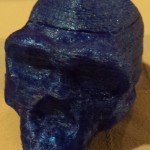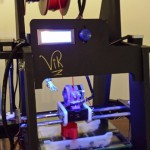Here’s the video of Claire’s talk at the Open Source Developers’ Conference 2015 (November) in Hobart, TAS.
 Open source has opened up huge opportunities for archaeologists. As well as high quality tools for research, we can use open source to engage kids with the past. Addressing the new National Curriculum, we use 3D printed fossil skulls and replicas of archaeological material to give kids a hands-on experience, making the past Funky and Fun!
Open source has opened up huge opportunities for archaeologists. As well as high quality tools for research, we can use open source to engage kids with the past. Addressing the new National Curriculum, we use 3D printed fossil skulls and replicas of archaeological material to give kids a hands-on experience, making the past Funky and Fun!
 Archaeologists are usually very good at sharing knowledge with each other and the wider world. Under Creative Commons licences many files are made available, including scans of fossil skulls, artefacts and other archaeological material. Using a suite of open source tools, including a 3D printer, a series of interactive experiences for school children has been developed allowing them hands-on involvement with this material.
Archaeologists are usually very good at sharing knowledge with each other and the wider world. Under Creative Commons licences many files are made available, including scans of fossil skulls, artefacts and other archaeological material. Using a suite of open source tools, including a 3D printer, a series of interactive experiences for school children has been developed allowing them hands-on involvement with this material.
The kids love examining the replica fossil skulls in their hands and learning about the changing features through time, as well as learning to measure and compare in a very real sense. These experiences are modern “we had 3D printed stuff in History class!”, engaging and fun for students and teachers alike, bringing the past alive.
This talk refers to some of the materials used in the OpenSTEM Introduction to Archaeology and Fossils Workshop. We have been fortunate to find quite a few more fossil skull models, and have already printed some of those also. The “family” is growing!
OpenSTEM also has an Integrated History/Geography Program for Primary Schools (full set of resources for F-6, including teacher handbooks, student workbooks and assessment guides), available from term 1, 2016.
There were many awesome talks at OSDC 2015 (Youtube playlist). See also the OSDC 2015 program overview.

 In this new OpenSTEM workshop developed and run by our resident archaeologist Claire, we set up a mock archaeological dig in a sandpit (or long jump pit) so that students can get a taste of life as an archaeologist.
In this new OpenSTEM workshop developed and run by our resident archaeologist Claire, we set up a mock archaeological dig in a sandpit (or long jump pit) so that students can get a taste of life as an archaeologist.



The kit was easy while still fun to build (except maybe for fitting the wires in). This was a fun…
Florence (15) and Keito (14), students at Hakusan International School